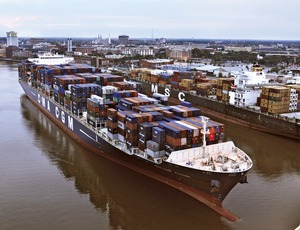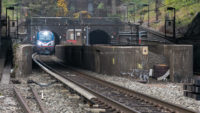
When the Water Resources Reform and Development Act was signed into law June 10, 2014, it was hailed as a major accomplishment. WRRDA was the first big Army Corps of Engineers water policy and authorization measure enacted in more than six years and a rare case of a bill winning strong Republican and Democratic support in a Congress tangled in partisan disputes.
As WRRDA reaches its one-year mark, industry officials point to some successes, especially regarding its higher spending targets from the Harbor Maintenance and Inland Waterways trust funds. But in other areas, WRRDA follow-through has been weaker. Few of the statute's 34 major authorized projects have received any appropriations or are in line to get them next year. Moreover, new WRRDA-launched innovative-finance programs are still at the starting gate.
Port interests have done particularly well so far. Jim Walker, American Association of Port Authorities director of navigation policy and legislation, says that, for fiscal year 2015, Congress appropriated $1.1 billion from the Harbor Maintenance Trust Fund for operation and maintenance work, just below WRRDA's 2015 target. For FY 2016, bills passed in recent weeks by the full House and the Senate Appropriations Committee would provide $1.25 billion, hitting WRRDA's goal, and up 14% from 2015. AAPA is pleased with how lawmakers are carrying out those provisions. "I give them high marks," says Walker.
Inland-navigation improvements are another WRRDA bright spot. One key provision shifts funding for the Ohio River Olmsted Locks and Dam project to 85% from the general fund and 15% from the Inland Waterways Trust Fund from a previous 50-50 match. Industry officials have grumbled that Olmsted's steep cost rise—to $2.9 billion from 1987's $775 million—has been squeezing out funds for other projects. Waterways projects also will benefit from a 9¢-per-gallon hike in the barge diesel-fuel levy, part of a separate tax-extensions bill enacted last December. The barge-tax increase should boost trust fund revenue by $80 million a year, according to Waterways Council Inc. The Olmsted shift will spread money to more projects. John Doyle, special counsel with law and lobbying firm Jones Walker LLP, says, "There's one example of promises made, promises being kept, at least by the Congress."
WRRDA authorized funds for 34 major projects with a total projected federal share of $15.6 billion. But, by ENR's count, only four of those received a total of $9.7 million in 2015 appropriations for studies, preconstruction engineering-design or construction. FY 2016 spending bills pending in Congress include $42.7 million for six WRRDA projects.
Those paltry results are reminders that a project's inclusion in WRRDA isn't the last word. Walker says, "You clear the hurdle of being authorized but you still have to clear the hurdle then of getting appropriations."
Of the fortunate few WRRDA projects with appropriations, the big winner so far is a deepening of the Savannah harbor. Last October, Georgia and Corps officials signed an agreement permitting the state to put up funds for the dredging while the Corps waits for congressional appropriations. Congress approved $3.5 million in appropriations for the project late last year. After those steps, the Corps signed a $134.5-million contract on March 5 with Great Lakes Dredge and Dock Co., Oak Brook, Ill., to deepen the outer harbor. President Obama included $29.7 million more for Savannah project construction in his FY 2016 Corps budget. House and Senate appropriations panel bills included that amount, too.
House and Senate anti-earmark policies have altered project funding. In the past, lawmakers didn't shy from inserting line-item allotments for projects in spending bills. But under the earmark bans, if a project's funding isn't included in a presidential budget proposal, legislators refrain from adding it in legislation. Obama's fiscal 2016 budget, proposed in February, had few WRRDA projects.
WRRDA innovative-finance programs are barely off the ground. The Water Infrastructure Finance and Innovation Act launched a low-interest loan program for Environmental Protection Agency and Corps water projects. WRRDA provided $375 million over five years for the program. That direct funding was expected to support several times that sum in loan volume. But Congress so far has only appropriated $2.2 million to EPA for startup costs and nothing for loans.
"EPA and their consultants have done a very good job of rolling out the program," says Barney Allison, a partner with law firm Nossaman LLP, Los Angeles. "But on the other side, the public [water] agencies are saying, 'Show us the money.'"
WRRDA also established a Corps pilot public-private partnership program for at least 15 projects, but the Corps had not yet identified any projects.
Rep. Bob Gibbs (R-Ohio), water resources and environment subcommittee chairman, said in April he was disappointed that the Corps hadn't put more priority on issuing guidance to its staff on how to implement WRRDA's provisions. In a June 9 statement to ENR, the Corps noted WRRDA's complexity and many programmatic changes and said it had published guidance for more than 70 of the law's 200-plus provisions.
Mike Strachn, a senior adviser with Dawson and Associates, Washington, D.C., says, "I think, all things considered, it's not surprising that the Corps is where it is in terms of implementation." He's hopeful that, in the rest of 2015 and into 2016, the Corps will issue additional policy guidance and that its FY17 budget proposal "will reflect a great deal more" for WRRDA projects and programs.



Post a comment to this article
Report Abusive Comment